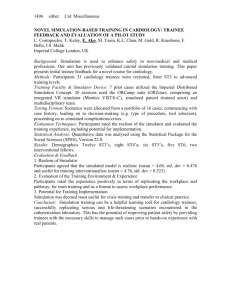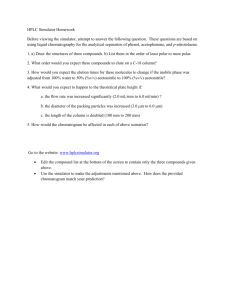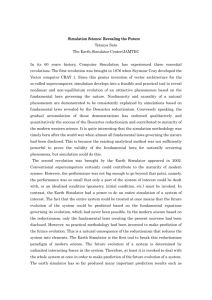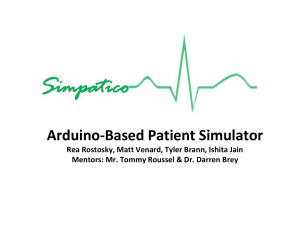Gryphon: Simulation Platform for Infectious Diseases Vaidyanathan and Kristofer Younger
advertisement
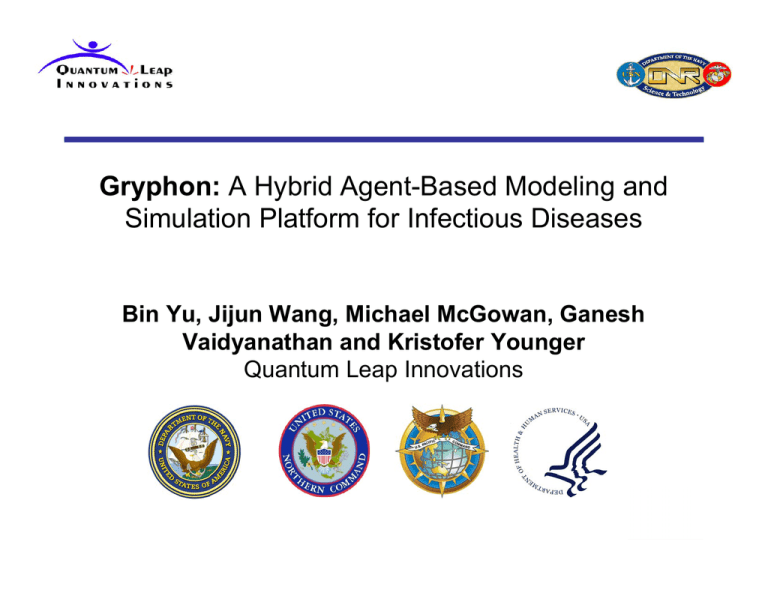
Gryphon: A Hybrid Agent-Based Modeling and Simulation Platform for Infectious Diseases Bin Yu, Jijun Wang, Michael McGowan, Ganesh Vaidyanathan and Kristofer Younger Quantum Leap Innovations 1 Agenda • Overview of infectious disease modeling • Gryphon modeling and simulation technologies • Validation studies • Conclusion 2 Overview of Infectious Disease Modeling • Compartmental models by sets of differential equations – Susceptible-infectious-recovered (SIR) or susceptible-exposedinfectious-recovered (SEIR) models 3 Overview of Infectious Disease Modeling • Highly complex individual-based models – Represent daily activities and connections of individuals via transmission networks – Often resorts to supercomputers and makes it impractical for quick what-if analyses of interventions or treatments under different conditions. 4 Gryphon Technologies 1. Compartmental models by sets of differential equations 2. 3. Highly complex individual-based models Gryphon®: Hybrid agent-based modeling and Simulation 5 Hybrid Agent-Based Modeling • Based on groups, not individuals – Behaviors of groups are modeled by rules (Behaviors) – Populations are decomposed into primary, secondary groups (Decomposition) A Top-Down Approach – Groups move among different locations and mix with each other at each location (Distribution) – The groups for mixing at a location are determined by the behaviors of different groups, not a migration matrix in Structured Population-SEIR (Mixing) 6 Benefits of a Top-Down Approach • Multi-scale modeling and simulation – State, county, age groups (top-down approach) – The level of abstraction for each group can be configured 7 Benefits of a Top-Down Approach • Real-time data-driven modeling & simulation – CDC surveillance data, e.g. ILNet (state Æ age groups) – Google FluTrend data (state Æ county) data-driven 8 Gryphon Platform Features Situational Awareness Contingency Planning Interactive what-if analysis • Enabling what-if analysis of interventions or treatments under different conditions Hybrid agent-based modeling • Rules/differential equations • Continuous/discrete time • Behaviors/interactions of agents Common Operational Picture Generalized visualization framework • 2D/3D GIS visualization • Data analysis of multiple runs data over time 9 Success Stories of the Gryphon Platform • • • • • Supported by ONR since 2007 Cobra Gold’08 (PACOM), 2008 spring Cyclone Nargis in Myanmar (PACOM), 2008 summer Swine Flu (NORTHCOM and CDC), 2009 spring Multi-user multi-scale M&S platform (DE HHS), 2010 spring Database model repository simulator simulator simulator simulator simulator simulator simulator simulator simulator analysis simulator pool analysis pool web services gryphoncloud platform web access 10 Gryphon Application for Swine Flu Disease Simulation for the US Northern Command Area of Responsibility (USNORTHCOM AOR) United States, Mexico, and Canada 11 Data and Methods for Validation Studies • Discrete time stochastic SEIR model for mixing • The timeline of SARS outbreak in Hong Kong and other Asian countries can be described as follows – February 15, 2003: Official report of a 33-year male and a 9 year old son in Hong Kong with Avian influenza (H5N1). – March 12, 2003: First global alert about atypical pneumonia in Vietnam and Hong Kong was issued by World Health Organization (WHO). – March 15, 2003: Second global alert about name of SARS and case definition was issued by WHO. • • The travel data sets are generated from the International Air Transport Association (IATA) (http://www.iata.org) database, which contains the number of available sets between any two given countries. The country data sets, including population, latitude and longitude for each country, are generated from the website (http://www.geonames.org). 12 Results for Local Transmission Dynamics • The estimated pairwise value of R0 for Hong Kong is consistent with Wallinga and Teunis’s work by assuming an exponential increase in the number of cases over time Wallinga, J., Teunis, P.: Different epidemic curves for severe acute respiratory syndrome reveal similar impacts of control measures. American Journal of Epidemiology 160(6) (2004) 509–516 13 Results for non-Local Transmission Dynamics • The predicated total case number for non-local disease transmission is close to the one given in Hufnagel’s PNAS paper in 2004, in which Hufnagel et al. used a continuoustime stochastic SEIR model. Hufnagel, L., Brockmann, D., Geisel, T.: Forecast and control of epidemics in a globalized world. PNAS 101(42) (2004) 14124–15129 14 Conclusion Gryphon: A scalable, flexible and interactive simulation platform Future Work Optimization of pharmaceutical and non-pharmaceutical interventions for infectious diseases Pharmaceutical interventions – Allocation of Antiviral and Vaccines at state and county levels Non-Pharmaceutical interventions – Isolation, quarantine, and school closure – Assessing the benefits of these strategies weighted against the cascading consequences that may arise from their use Modeling complex and adaptive behaviors of populations 15
